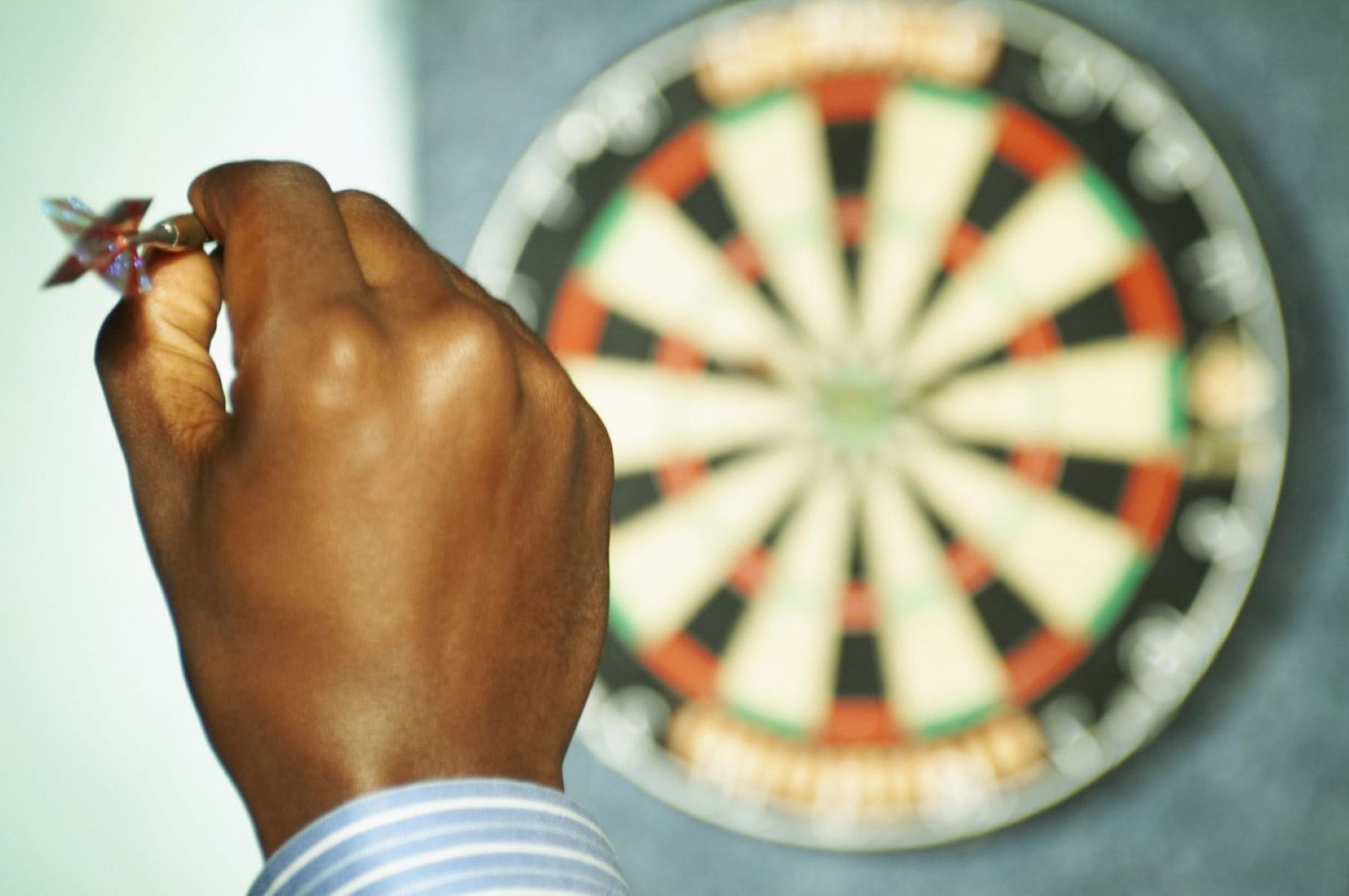

Sports
How To Throw A Dart
Published: February 26, 2024
Learn the proper technique and tips for throwing a dart in this comprehensive guide to improve your accuracy and precision in sports. Master the art of dart throwing with expert advice and step up your game today!
(Many of the links in this article redirect to a specific reviewed product. Your purchase of these products through affiliate links helps to generate commission for Regretless.com, at no extra cost. Learn more)
Table of Contents
Introduction
Darts is a classic and engaging game that has been enjoyed by people of all ages for centuries. Whether you are a casual player looking to have fun with friends or a serious competitor aiming for precision and accuracy, mastering the art of throwing a dart can be immensely rewarding. From choosing the right equipment to perfecting your throwing technique, there are various elements to consider when delving into the world of darts.
In this comprehensive guide, we will explore the essential aspects of throwing a dart, providing valuable insights and practical tips to help you elevate your game. From selecting the ideal dart to understanding the nuances of scoring and game variations, this article aims to equip you with the knowledge and skills needed to become a proficient dart player.
Darts is not just a game of skill; it also requires focus, strategy, and a keen understanding of the mechanics involved in achieving precision and accuracy. As we delve into the intricacies of dart throwing, you will discover the importance of proper stance, grip, and aiming techniques, all of which play a pivotal role in determining your success on the dartboard.
Whether you are a novice seeking to improve your skills or a seasoned player looking to refine your technique, this guide will serve as a valuable resource to enhance your darts experience. So, grab your darts, step up to the oche, and let's embark on a journey to master the art of throwing a dart.
Read more: How To Play Darts To Darts Rules
Choosing the Right Dart
Selecting the right dart is a crucial aspect of honing your skills in the game of darts. With a myriad of options available, it's essential to consider various factors to ensure that the dart you choose aligns with your playing style and preferences.
Weight and Balance
The weight of a dart significantly impacts its trajectory and accuracy. Darts typically range from 12 to 50 grams, and finding the ideal weight for your throwing style is paramount. Heavier darts offer more stability in flight and may suit players who prefer a stronger throw, while lighter darts provide swifter movement through the air, catering to those who favor a gentler release. Additionally, the balance of the dart, determined by the distribution of weight along its length, can influence its stability during flight. Experimenting with different weights and balances will help you identify the optimal combination that feels comfortable and enhances your accuracy.
Barrel Grip and Material
The barrel of a dart is where the player grips the dart before releasing it. Barrels come in various shapes, including straight, torpedo, and scallop, each offering distinct tactile experiences. Furthermore, the material of the barrel, such as tungsten, brass, or nickel-silver, affects the grip and durability of the dart. Tungsten darts, known for their high density, provide a slimmer profile without compromising weight, offering enhanced precision and reduced bounce-outs. Conversely, brass darts offer a more affordable option and are suitable for players seeking a wider barrel and a comfortable grip. Understanding your grip preference and the tactile feel of different barrel materials is essential in choosing the right dart for your game.
Flight and Shaft
The flight, or wing, of a dart plays a pivotal role in stabilizing its trajectory as it travels through the air. Flights come in various shapes, including standard, kite, and slim, each influencing the dart's aerodynamics and stability. Additionally, the shaft, which connects the flight to the barrel, comes in different lengths and materials, such as nylon, aluminum, and carbon fiber. Experimenting with different flight and shaft combinations can help you fine-tune the dart's flight path and overall performance, catering to your throwing technique and playing environment.
By considering these factors and experimenting with different dart configurations, you can identify the perfect dart that complements your playing style, enhances your accuracy, and elevates your overall darts experience.
Read more: How To Throw A Bowling Ball
Setting Up the Dartboard
Setting up the dartboard is a fundamental step in creating an optimal playing environment for darts. Proper installation ensures that the dartboard is securely positioned at the regulation height and distance, allowing players to engage in fair and competitive gameplay. Whether you are preparing for a casual game at home or a professional tournament, adhering to the standard setup guidelines is essential for an authentic darts experience.
Regulation Height and Distance
The standard height for mounting a dartboard is 5 feet 8 inches (1.73 meters) from the floor to the center of the bullseye. This height provides an optimal vantage point for players to aim and throw their darts effectively. When measuring the height, it is crucial to use a reliable tape measure and ensure that the dartboard is securely affixed to the wall at the designated position.
In addition to the height, the throwing distance, also known as the oche or toe line, is a critical aspect of setting up the dartboard. The regulation throwing distance is 7 feet 9.25 inches (2.37 meters) from the face of the board to the front of the oche. This distance allows players to maintain a consistent and fair playing field, ensuring that all participants have an equal opportunity to showcase their dart-throwing skills.
Mounting the Dartboard
When mounting the dartboard, it is essential to use a sturdy and stable backing material, such as a wooden board or a specialized dartboard cabinet. The backing material should be securely fixed to the wall, providing ample support for the dartboard and minimizing vibrations during gameplay. Additionally, using a spirit level to ensure that the dartboard is perfectly horizontal is crucial for maintaining accuracy and fairness in dart throwing.
Lighting and Surrounding Environment
Proper lighting is vital for creating an optimal dart-playing environment. Adequate illumination ensures that players can clearly see the dartboard and their targets, minimizing visual strain and enhancing overall gameplay. Additionally, considering the surrounding environment, such as minimizing potential obstructions and providing sufficient space for players to move around the dartboard, contributes to a comfortable and enjoyable darts experience.
By meticulously following the standard guidelines for setting up the dartboard, players can create a conducive and authentic playing environment, setting the stage for engaging and competitive dart games. Whether in a recreational setting or a professional tournament, the proper setup of the dartboard is a foundational element in fostering a rewarding and enjoyable darts experience.
Read more: How To Throw A Sinker
Proper Stance and Grip
Mastering the proper stance and grip is essential for achieving consistency and accuracy in dart throwing. The stance refers to the positioning of your body in relation to the dartboard, while the grip pertains to how you hold the dart before releasing it. Both elements are integral to executing a successful throw and maximizing your scoring potential.
Stance
Your stance forms the foundation of your throwing technique. Begin by positioning yourself squarely facing the dartboard, with your feet shoulder-width apart. Distribute your weight evenly on both feet, maintaining a stable and balanced posture. Avoid leaning excessively forward or backward, as this can disrupt your body's alignment and affect your throwing motion.
As you prepare to throw, align your dominant eye with the target on the dartboard. This ensures that your visual focus is optimized, allowing for greater precision when aiming at specific scoring areas. Additionally, keeping your non-throwing hand steady and extended toward the board can serve as a visual guide, aiding in target alignment and enhancing your overall throwing consistency.
Grip
The grip is a highly personalized aspect of dart throwing, as it directly influences the release and trajectory of the dart. Experimenting with different grip styles and positions is crucial in finding the most comfortable and effective technique for your individual playing style.
One common grip technique is the "pencil grip," where the dart is held between the thumb, index, and middle fingers, providing stability and control during the throw. Alternatively, the "hammer grip" involves gripping the dart with all four fingers, offering a secure and balanced hold. Whichever grip style you choose, it is essential to maintain a relaxed and consistent grip pressure, allowing for a fluid and natural release of the dart.
Integration of Stance and Grip
Achieving synergy between your stance and grip is key to executing a seamless and effective throw. As you adopt your stance and grip the dart, focus on maintaining a fluid and coordinated motion, minimizing any unnecessary tension or rigidity in your body. This integration facilitates a smooth transfer of energy from your stance to your throwing arm, culminating in a controlled and accurate release of the dart.
By honing your stance and grip through deliberate practice and mindful adjustments, you can elevate your dart-throwing proficiency and enhance your overall performance on the dartboard. Embracing a balanced and stable stance, coupled with a personalized and refined grip, empowers you to unleash precise and consistent throws, setting the stage for an exhilarating and rewarding darts experience.
Read more: How To Throw A Changeup
Aiming and Throwing Techniques
Aiming and throwing techniques are pivotal components of mastering the art of dart throwing. Achieving precision and accuracy on the dartboard requires a combination of focus, control, and strategic execution. Whether you are aiming for a specific target or honing your ability to consistently hit high-scoring areas, understanding the nuances of aiming and refining your throwing technique can significantly elevate your performance in darts.
Visual Focus and Target Alignment
Central to effective aiming in darts is the ability to maintain unwavering visual focus on the intended target. As you prepare to throw, fixate your gaze on the specific segment of the dartboard that you aim to hit. By concentrating your attention on the desired target, you enhance your visual acuity and spatial awareness, laying the groundwork for a more accurate and purposeful throw.
Moreover, aligning your body and throwing arm with the target area is essential for achieving precision. Ensure that your stance and posture facilitate a direct line of sight to the intended scoring zone, allowing for a seamless transfer of visual focus to the dartboard. This alignment optimizes your throwing trajectory and minimizes deviations, increasing the likelihood of hitting your desired target consistently.
Release and Follow-Through
The release of the dart is a critical moment that determines its trajectory and eventual landing position on the dartboard. A smooth and controlled release, characterized by a fluid extension of the throwing arm and a decisive unclenching of the fingers, is essential for imparting the desired spin and velocity to the dart. Maintaining a consistent release technique, devoid of abrupt jerks or hesitations, fosters a more predictable flight path and enhances your overall throwing accuracy.
Furthermore, the follow-through after releasing the dart plays a crucial role in reinforcing your throwing motion and ensuring a balanced delivery. Emphasize a natural and unhurried follow-through, allowing your throwing arm to extend forward in the direction of the target after the release. This extension promotes a cohesive transfer of energy and imparts a sense of continuity to your throwing action, contributing to a more controlled and purposeful throw.
Adaptation and Adjustment
Adaptability is a key attribute in dart throwing, particularly when aiming at different scoring areas or adjusting to varying playing conditions. As you refine your aiming and throwing techniques, remain open to making subtle adjustments based on the specific targets you are aiming for and the prevailing environmental factors, such as lighting and air circulation.
Experimenting with different release points and angles can offer valuable insights into optimizing your throwing trajectory for specific scoring segments, allowing you to adapt your technique to varying distance and elevation considerations. Additionally, embracing a flexible approach to your aiming strategy empowers you to recalibrate your focus and refine your throwing motion in response to evolving game scenarios, ultimately enhancing your ability to consistently hit your intended targets.
By honing your visual focus, perfecting your release and follow-through, and embracing adaptability in your aiming strategy, you can elevate your dart-throwing proficiency and unlock new levels of precision and accuracy. Embracing these fundamental aiming and throwing techniques empowers you to navigate the intricacies of the dartboard with confidence and finesse, setting the stage for a captivating and rewarding darts experience.
Read more: How To Throw A Frisbee Golf Disc
Scoring and Game Variations
Scoring lies at the heart of dart games, adding an element of strategy and excitement to each throw. Understanding the scoring system and exploring the diverse game variations not only enriches the darts experience but also offers a multitude of engaging options for players of all skill levels.
Scoring System
In traditional darts, the standard scoring system involves aiming to accumulate points by hitting specific segments of the dartboard. The outer ring, known as the double ring, doubles the score of the respective segment, while the inner, smaller ring, referred to as the triple ring, triples the score. Additionally, hitting the bullseye, comprising the outer bull and the inner bullseye, yields 25 and 50 points, respectively. The objective is to reach a predetermined total, often 301 or 501, by subtracting the points scored from the initial total with each turn.
Popular Game Variations
Darts enthusiasts can explore an array of game variations, each offering unique challenges and strategic nuances. One of the most widely played variations is '501,' where players start with a score of 501 and aim to reach zero by subtracting their scores from the initial total. '301' follows a similar format, providing a faster-paced alternative for players seeking a brisk and exhilarating game.
The 'Cricket' game variation introduces a different scoring approach, focusing on specific segments of the dartboard. Players aim to close out designated numbers, such as 20 through 15 and the bullseye, while strategically preventing their opponents from doing the same. This tactical game variation emphasizes precision and strategic thinking, adding a layer of complexity to the scoring dynamics.
For those seeking a collaborative and social darts experience, 'Killer' or 'Elimination' offers an engaging team-based game format. Players take turns to hit specific targets, aiming to eliminate their opponents by accumulating points and strategically targeting their rivals' designated numbers. This interactive and dynamic game variation fosters camaraderie and friendly competition, making it a popular choice for social gatherings and darts leagues.
Advanced Variations and Customization
Beyond the traditional and popular game variations, darts enthusiasts can delve into advanced formats and customizable game rules to tailor the experience to their preferences. Variations such as 'Around the Clock' challenge players to hit each segment of the dartboard in sequential order, testing their accuracy and consistency across the board.
Moreover, players can introduce personalized rules and scoring mechanics to create custom game variations, fostering creativity and adaptability. Whether incorporating handicaps to level the playing field or devising innovative scoring methods, the flexibility of darts game variations allows for endless possibilities, catering to diverse playing styles and preferences.
Exploring the rich tapestry of darts game variations not only adds depth and excitement to the darts experience but also fosters a sense of camaraderie and friendly competition among players. From traditional scoring systems to innovative game formats, the world of darts offers a wealth of opportunities for players to immerse themselves in the thrill of precision, strategy, and skill.
Conclusion
In conclusion, mastering the art of throwing a dart encompasses a multifaceted journey that intertwines skill, precision, and strategy. From the initial selection of the right dart to the immersive exploration of game variations, the world of darts offers a captivating tapestry of experiences for players of all levels. As we reflect on the essential elements of dart throwing, it becomes evident that the pursuit of excellence in this timeless game transcends mere proficiency; it embodies a harmonious blend of technique, adaptability, and camaraderie.
The process of choosing the right dart serves as a foundational step in aligning the player's equipment with their individual playing style and preferences. By considering factors such as weight, balance, grip, and flight, players can embark on a personalized quest to discover the dart that resonates with their unique approach to the game. This pursuit not only enhances the player's physical connection to the dart but also fosters a sense of ownership and familiarity, laying the groundwork for a more immersive and rewarding darts experience.
Furthermore, the meticulous setup of the dartboard creates a conducive environment for players to engage in fair and competitive gameplay. Adhering to the standard regulations for height, distance, and lighting ensures that the dartboard becomes a focal point for precision and skill, setting the stage for captivating encounters and memorable moments of triumph and camaraderie.
Delving into the nuances of proper stance and grip unveils the intricate interplay between body mechanics and throwing technique. By embracing a balanced and stable stance, coupled with a personalized and refined grip, players can unleash precise and consistent throws, elevating their dart-throwing proficiency and setting the stage for an exhilarating and rewarding darts experience.
The exploration of aiming and throwing techniques unveils the artistry and finesse inherent in dart throwing. From maintaining unwavering visual focus to executing a smooth release and follow-through, players can harness these fundamental techniques to navigate the intricacies of the dartboard with confidence and finesse, unlocking new levels of precision and accuracy.
Lastly, the rich tapestry of darts game variations offers a wealth of opportunities for players to immerse themselves in the thrill of precision, strategy, and skill. Whether embracing traditional scoring systems or venturing into innovative game formats, the world of darts invites players to embark on a dynamic and enriching journey, fostering a sense of camaraderie and friendly competition.
In essence, the art of throwing a dart transcends the boundaries of a mere game; it embodies a captivating fusion of skill, strategy, and camaraderie, inviting players to embark on a timeless quest for excellence and enjoyment. As players step up to the oche, armed with knowledge, skill, and passion, they embark on a journey that transcends the physical act of throwing a dart, embracing the essence of precision, strategy, and the enduring spirit of camaraderie that defines the timeless allure of darts.










